

| Greetings | The Rally | Results | Map - Route | Gallery | Sponsons |
Monday 27 May 2013
The Start was performed by the Mayor of the city at 12:00hrs form the Enaerios Parking place. in Limassol. Enaerios, (cable train) took its name from the cable train that used to carry asbestos from the mines of Amiantos village on the Troodos mountains, to Limassol for export. With the ban of asbestos, the area there was transformed into a lovely botanical garden thanks to the generous donations of the Leventis foundation.
First stop at Kolossi Castle. The castle was first built by Richard the Lion Heart in 1190.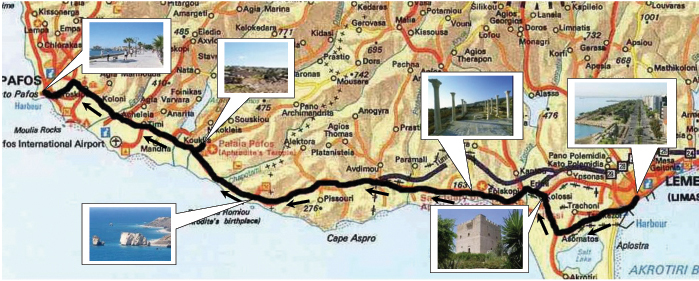
It was restored and used by the Knights of the order of St. John of Jerusalem (Commanderie) in the 15th Century. The name of the sweet wine Commandaria which is been produced since the Middle Ages is associated with this place.
Next to it there are still the remains of the sugar cane refinery which was one of the main exports of Cyprus in the Middle Ages. Sugar cane was also growing in the Larnaca and Paphos areas.
On the way we passed by Aphrodite's Rock, or Digenis Stone, as it is called. Two traditions characterize these rocks in the sea of Paphos:
According to mythology, Goddess Aphrodite was born from the foam of the sea here. A local myth says that any person who swims around the Rock of Aphrodite will be blessed with eternal beauty.
Another legend claims that Digenis Akritas, a Greek hero of the Byzantine Period (330-1191 AD), threw a large rock to destroy the pirate ships of the Saracens. Today, this rock stands as the “Petra Tou Romiou” - meaning "Rock of the Greek."
Next stop Goddess Aphrodite’s sanctuary at Kouklia. The Goddess was worshiped here since the Chalcolithic period (c 2800 BC) to the late Roman period (4th century AD) as the Goddess of fertility, love and beauty. The Goddess was represented by a conical idol of local stone, found on the site and now in the museum. She was also known as Astarte, the great goddess of the Middle East, but also as Anassa or Wanassa (Queen) up until the end of the Bronze Age (1050 BC) when she was finally named Aphrodite.
Interesting items to notice at the museum are the mosaic panel of Leda and the Swan, as well as a sarcophagus with scenes from Odyssey. There are also many items related to the production of sugar during the Middle Ages.
East of the sanctuary stands a little Christian church which, up until the 18th century was called Panagia Aphroditissa (our Lady of Aphrodite).
The route of the day ended up at the Paphos Castle by the harbour. The Castle dates back to the Byzantine era (before the 12th Century AD). In its present form it was rebuilt in the 16th century, during the Ottoman Period. The area around it is now used for numerous cultural events, the most famous of which being the Aphrodite Festival, which takes place on the first weekend of September with a different opera every year.
Tuesday 28 May 2013
Goddess Aphrodite used to take her bath at the natural spring of Akamas peninsula on the north western part of the Island. Our first stop of the day therefore was Aphrodite’s baths east of the fishing village of Latchi. Recently the place has been transformed into a biological garden with trees and plants native to this area of Cyprus.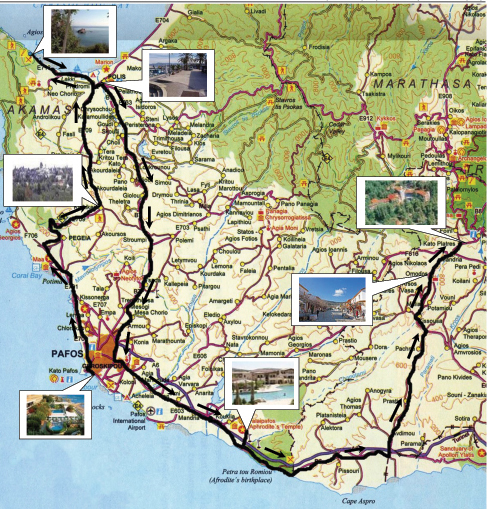
The route ended up at the Lambouris winery on the mountain resort of Platres. Overnight stay at the FOREST PARK Hotel. there we had to opportunity to hear about the many celebrities that stayed in this well known hotel, like King Farouk of Egypt, Prime Minister of India Indira Ghandi, the famous author Daphne du Maurier, and many others, from the owner and member of our Federation Eraklis Skyrianides. We also admired his selection of old cars that have been in his family from new.
We tried the “Brandy Sour” the cocktail that was created by Stelios, the barman around 1945, for king Farouk, when, as a young prince he wanted an alcoholic drink that looked like tea. Also, those who prefered a non-alcoholic drink, had a “Brandy Sour without the Brandy” that was created in 1960 by the then barman Yiannis.
Wednesday 29 May 2013
Start for the FOREST PARK Hotel. The route took us on the pine-clad Troodos mountains. Lunch at a local tavern on the way, just outside Kakopetria.
The area there has many stones that were used by the inhabitants for the foundation of their houses.
The name Kakopetria means Bad Rock; (Kako-Petria = Bad Rock). The story goes like this: One of the largest stones lies at the head of the river, before the river divides. Below it lies the bridge that was once part of the old road from Kakopetria on the one side, and to Troodos on the other. The stone clearly marks the beginning of the old village and serves as a gateway from the new to the old. The stone is called the Stone of the Newly-weds, i.e. Petra tou Androginou = Stone of the Couple. The reason is that by tradition, couples after the wedding ceremony stood on it to make a wish.
However, during one of the ceremonies when the couple stepped on it, the stone rolled over, resulting in their deaths.
In recent years the base of the stone has been cemented to prevent it rolling again.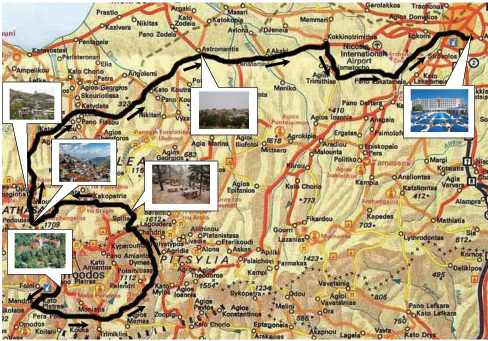
Kakopetria is also known for its excellent wine that is produced from the vineyards one the slopes of the mountains here.
Clarke, who visited the Island in 1812 wrote:
“The wine of the island is so famous all over the Levant, that, in the hyperbolical language of the Greeks, it is said to possess the power of restoring youth to age, and animation of those who are at the point of death”.
Thursday 30 May 2013
Thursday’s route started from the Olympic Building in Nicosia. The Cyprus National Olympic Committee was founded on the 10th of June 1974. It became a member of the International Olympic Committee on the 10th of April 1979. The Cyprus Federation of Classic Vehicles is an associated member of the Olympic Committee since 2006.
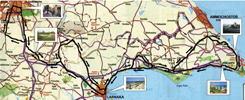
The Building was inaugurated in 2006, and the first event to take place was the 3rd “Cyclamen Rally”, a bi-communal classic car rally that was started by the Mercedes-Benz Club Cyprus in order to bring Greek and Turkish Cypriots together. The rally run for 7 consecutive years and was sponsored by the Ministry of Interior. today Greek and Turkish Cypriots meet often to drive enjoy their classic car together.
The route took us towards the far eastern part of the Island. This is a favourite tourist resort, loved by both locals who have summer houses there, but also by tourists from abroad. The area was developed after 1974. Up until then it was a farmer’s area, with many windmills that drew water from the wells for irrigation.
We had lunch at the CAPO BAY Hotel, one of the best hotels of the area.
In the afternoon we visited the Larnaca see front “Phinikoudes” as it is called, on account of the palm trees that were planted here a century ago. The city is proud to have been the birth place of Zenon, the Philosopher, who lived and taught in ancient Athens (334 - 262 BC). Here also we saw the bust of Kimon, the Greek admiral who died fighting during the Persian Wars (c.450BC). His men kept his death a secret until the Persian fleet and army were defeated.
Friday 31 May 2013
Start from the Hilton Hotel.
First stop the Hala Sultan Tekke Mosque. This Muslim shrine is the burial place of Um Haram, a relative of Mohamed, who died when she fell off her horse, when she was accompanying her husband (647-639AD) during one of the Arab attacks during the Byzantine Period.
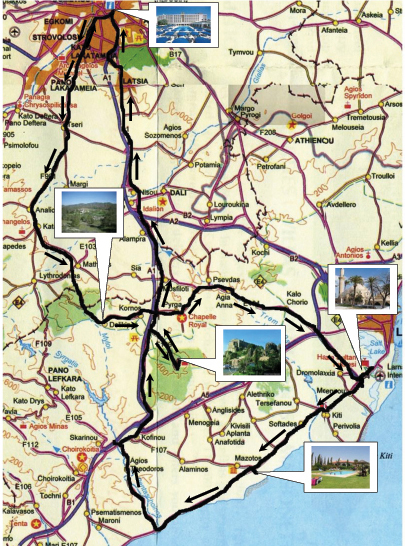
Next visit, the Camel Park and lunch there. Again, up until the middle of the 20th century one could see caravans of camels carrying goods on the Cyprus plains. Now, these animals have found refuge there, and those who felt adventurous, had the opportunity to take a camel ride around the park. The area is full of olive and carob trees. Carobs used to be exported in the previous centuries. We also tried the “pasteli”, a local sweetmeat made from carob syrup, nuts and sesame seeds.
Our last stop was the Stavrovouni hill. History has it that Santa Helena, the Mother of Byzantine Emperor Constantine, stopped in Cyprus on her way back from the Holy Lands where she had gone to find the holy Cross. One morning, she woke up to find that the Cross was missing, but she saw a bright light on the top of a hill opposite the Larnaca Harbour where he ship was anchored. There she found the Holy Cross. She built a Monastery and donated a piece of the Holy Cross there. The Monastery of Stavrovouni (Mountain of the Cross) is connected with the Mount Athos Monasteries, where no women are allowed. The view from there is beautiful.
|
Cyprus Federation of Classic Vehicles (OKAK)
|